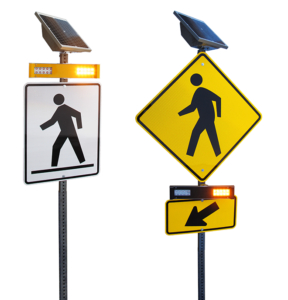EVALUATION OF PEDESTRIAN HYBRID BEACON AND RAPID FLASHING BEACONS
RRFB and Driver Hazard Detection
To prevent RRFB devices from being set at brightness levels that produce disability or discomfort glare in drivers, the profession needs to quantify the effect of bright traffic control devices on a driver’s ability to detect pedestrians in and around the crosswalk.
This closed-course study was designed to examine drivers’ ability to detect pedestrians in and around crosswalks. Specifically, it examined the effect of traffic control device brightness and other characteristics on drivers’ ability to quickly and accurately identify the presence of a pedestrian and then discern the pedestrian’s direction of travel.
For flashing traffic control devices, there are two important and competing considerations in designing the brightness of traffic control devices:
- Is the brightness high enough to command the driver’s attention and elicit the desired response (e.g., yielding to pedestrians)?
- Is the brightness low enough that it does not impair a driver’s ability to see pedestrians because of disability or discomfort glare?
For a well-designed traffic control device, the answers to both questions need to be yes, yet the measure of brightness associated with these two questions may not be the same.
(FHWA Technical Report HRT-16-040)


